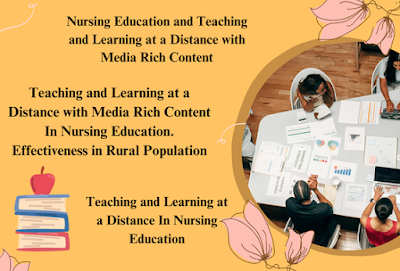The Teaching and Learning at a Distance with Media Rich Content and Its Needs In Nursing Education. It has enormous capacity and can be updated quickly; it is rich in content and diverse in form; it is highly shareable and easily accessible; it is complex and messy.
The Teaching and Learning at a Distance with Media Rich Content and Its Needs In Nursing Education
Distance learning in nursing education, especially with media-rich content, offers flexible and accessible learning opportunities. Various technologies and media are used to connect faculty and students regardless of location. This approach utilizes tools such as online platforms, simulations, and virtual reality to enhance learning and provide a more immersive experience that meets the needs of diverse learners.
The teaching/learning process follows the same steps as the nursing process, including assessment, diagnosis, outcome evaluation, planning, implementation, and evaluation, but in the following manner: Assessment: Data is collected about the client, their willingness to learn, and their current level of knowledge on the subject.
Distance with Media Rich Content Technological advances have revolutionized the way education is delivered, especially in fields like nursing where practical and theoretical knowledge are equally important. With increasing demands for flexible learning, nursing education is shifting towards distance learning, offering students the ability to learn at their own pace while accessing media-rich content. This approach not only broadens student access but also addresses critical issues such as faculty shortages and the need for healthcare professionals in rural areas.
The Role of Distance Learning in Nursing Education
Distance learning allows students to receive instruction from anywhere, breaking the traditional boundaries of classroom-based learning. It’s particularly valuable for nursing students in rural and underserved communities, where the need for qualified healthcare professionals is urgent. By educating students in these areas, there’s a higher chance that they will continue practicing in their local communities after graduation, thus improving healthcare access (Skillman et al., 2014).
Distance education also helps to alleviate the shortage of nursing faculty, a problem expected to worsen due to retirements in the coming years (AACN, 2014). Through online platforms, students can connect with expert faculty across distances, allowing for specialized learning and increased faculty efficiency (Billings, 2010).
Media-Rich Content: Enhancing Learning Experiences
The integration of media-rich content—such as videos, simulations, and interactive modules—has become a game-changer in nursing education. These tools provide dynamic, real-time learning experiences, helping students grasp complex concepts. With the right technology, educators can now create a virtual classroom where students can engage in practical, hands-on experiences, even from remote locations.
The ability to access online lectures, recorded demonstrations, and live video sessions allows students to learn at their own pace, reducing the need for physical presence while still gaining a comprehensive education. As noted by Shachar & Neumann (2010), distance learning is often equal to or even superior to traditional classroom instruction in terms of student outcomes.
Needs of Faculty and Institutions in Distance Learning
As distance learning grows, nursing faculty must become proficient with new technologies. This requires continuous development and training to ensure that educators are comfortable and effective in digital teaching environments (Gerard et al., 2014). However, with the rapid evolution of technology, obsolescence is inevitable. Institutions must stay ahead by updating their systems and ensuring that both faculty and students have access to state-of-the-art tools.
Moreover, faculty need sufficient resources and time to develop media-rich content and course materials well in advance of course delivery (Keengwe & Kidd, 2010). Adequate support for faculty and students alike is crucial for successful distance education programs, ensuring that both have the necessary skills to navigate learning management systems (LMS) and other digital platforms.
The Blended Learning Approach: A Hybrid Solution
Blended learning, which combines online instruction with face-to-face interactions, has been gaining traction in nursing education. This hybrid model offers the best of both worlds—flexibility and interaction. Blended learning environments have proven particularly effective, with studies showing that they produce better learning outcomes than purely online or traditional methods (US Department of Education, 2009).
Synchronous technologies, such as live video conferencing, allow students to participate in real-time discussions and practical sessions without the need to travel. This is particularly beneficial for rural students, who may face logistical challenges in attending on-site classes. On the other hand, asynchronous learning platforms enable students to access recorded lectures, assignments, and resources at their convenience, catering to varying schedules and time zones.
Addressing Challenges in Rural Nursing Education
In rural areas, where access to education and healthcare is limited, distance learning has the potential to transform the landscape. By offering flexible, media-rich educational programs, institutions can bridge the gap between urban and rural healthcare education. Moreover, distance learning can encourage rural students to remain in their communities post-graduation, thereby addressing healthcare shortages in these regions (Skillman et al., 2014).
However, there are challenges to consider. Reliable internet access, for instance, remains a hurdle in many rural communities. Institutions must work towards ensuring that students have the necessary resources to participate fully in distance education. Additionally, practical, hands-on training must still be integrated into distance programs through virtual simulations or periodic in-person sessions.
Conclusion
Distance learning, particularly with media-rich content, is reshaping the future of nursing education. By increasing access to education in rural and underserved areas, it has the potential to address critical healthcare gaps while also responding to the growing demand for flexibility in learning. As technology continues to evolve, so too will the tools and methods available for distance education, ensuring that nursing students are well-prepared for their careers, no matter where they are located.
Read More:
https://nurseseducator.com/didactic-and-dialectic-teaching-rationale-for-team-based-learning/
https://nurseseducator.com/high-fidelity-simulation-use-in-nursing-education/
First NCLEX Exam Center In Pakistan From Lahore (Mall of Lahore) to the Global Nursing
Categories of Journals: W, X, Y and Z Category Journal In Nursing Education
AI in Healthcare Content Creation: A Double-Edged Sword and Scary
Social Links:
https://www.facebook.com/nurseseducator/
https://www.instagram.com/nurseseducator/
https://www.pinterest.com/NursesEducator/
https://www.linkedin.com/in/nurseseducator/
https://www.researchgate.net/profile/Afza-Lal-Din
https://scholar.google.com/citations?hl=en&user=F0XY9vQAAAAJ
